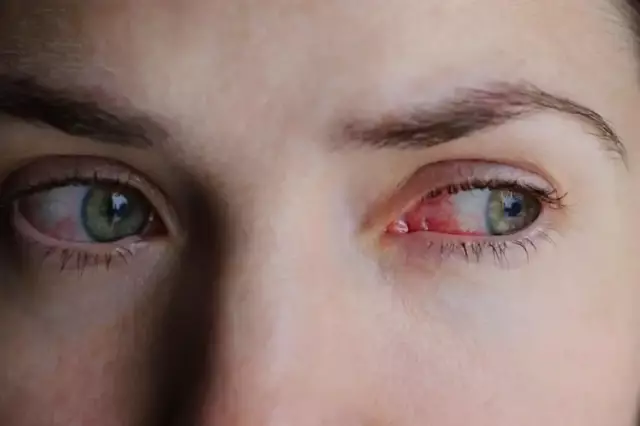- Author Curtis Blomfield [email protected].
- Public 2023-12-16 20:44.
- Last modified 2025-01-23 17:01.
Today, bacterial conjunctivitis is considered a very common disease. The disease is accompanied by inflammation of the mucous membrane of the eye (conjunctiva), which is associated with the activity of pathogenic bacterial microorganisms.
Many people are looking for information about this disease. What is inflammation associated with? Are there risk factors? What to do if a child has been diagnosed with bacterial conjunctivitis? Is such a disease dangerous? The answers to these questions are important to many readers.
Main causes of disease development

This disease is very common in ophthalmic practice, and bacterial conjunctivitis is most often diagnosed in children. Treatment in this case is necessary, as the disease is highly contagious and spreads rapidly (for example, among children in kindergarten, at school, etc.).
The cause of the inflammatory process of the mucous membrane of the eye can be any pathogenic bacterium. But as statistics show, in most cases the pathogenis Escherichia coli, pneumococcus, Staphylococcus aureus, chlamydia, Pseudomonas aeruginosa and Haemophilus influenzae. Gonococcus can also cause conjunctivitis (bacterial conjunctivitis in adults sometimes develops with gonorrhea).
Infection in most cases is transmitted during contact with a sick person. It is possible to spread bacteria in a household way (for example, when using the same towel, toys and other items). A newborn baby can become infected from the mother while passing through the birth canal.
Are there risk factors?

It is worth saying right away that the mucous membrane of the eye is constantly in contact with certain pathogenic microorganisms. But, as you know, tear fluid has antibacterial properties, as it contains lysozyme, immunoglobulins, beta-lysine, etc. The likelihood of developing an inflammatory process increases when exposed to certain risk factors. Their list is worth checking out:
- strong local or general hypothermia of the body;
- stress conditions (lead to changes in hormonal levels and disruption of the immune system);
- decreased immunity, increased susceptibility to various infections;
- presence of pathologies of ENT organs (bacterial conjunctivitis often develops against the background of otitis media, sinusitis, tonsillitis);
- previous infectious diseases that weakened the body;
- presence of erythema multiforme in a patient;
- wearing contactslenses.
What symptoms accompany the disease?
In fact, the disease is accompanied by obvious symptoms. As a rule, a slight irritation in the eye occurs first. Patients complain of burning and itching in the eyes. Conjunctivitis is accompanied by swelling of the mucous membrane and eyes.

Viscous cloudy discharge from the conjunctival cavity appears quite quickly. They are mucopurulent in nature, have a gray, yellow or greenish tint. The secretions are quite plentiful, their production does not stop even at night. That is why the eyelids of the patient stick together during sleep - it is difficult to open the eyes in the morning.
Patients are concerned about the constant sensation of a foreign body in the eye. There is profuse lacrimation, increased sensitivity to light. When examining the eyes, you can notice small, pinpoint hemorrhages.
In more severe cases, conjunctivitis is accompanied by systemic symptoms. Patients sometimes complain of weakness, drowsiness, headaches. The infection can spread to the upper respiratory organs. Body temperature may rise to subfebrile values.
Shapes
Bacterial eye conjunctivitis can occur in different ways. There are three main forms of this disease:
- Lightning fast - accompanied by very vivid symptoms. The incubation period rarely exceeds 1-3 days. Mucosal inflammation disorders progress very quickly. In this case, it is extremely important to start therapy on time, since there is a high probabilitycorneal damage.
- The acute form is characterized by less severe symptoms than fulminant bacterial conjunctivitis. The disease is accompanied by the release of copious amounts of pus. Therapy usually lasts about 10-14 days.
- The chronic form of inflammation in most cases is associated with tissue damage by Staphylococcus aureus. The symptoms in this case are blurred, patients complain of discomfort in the eyes. Chronic conjunctivitis is often associated with blepharitis and is difficult to treat.
How can I tell viral from bacterial conjunctivitis?

Inflammation of the mucous membrane of the eye develops against the background of penetration into the body of both viruses and bacteria. The nature of the pathogen will be determined by the doctor during the diagnosis. By the way, treatment largely depends on this (for example, antibiotics will not have an effect on viral inflammation).
Of course, there are some differences in the clinical picture. For example, bacterial conjunctivitis is accompanied by the appearance of copious purulent discharge. At the same time, discharge against the background of viral inflammation is sometimes practically absent. On the other hand, the invasion of viruses is accompanied by severe burning, swelling, itching, minor bleeding, causing the eyes to become red. With bacterial inflammation, these symptoms are less pronounced.
Possible Complications
Treatment of bacterial conjunctivitis in adults and children in most cases ends with complete recovery. However, the probabilitycomplications still exist, especially if the patient refused therapy or it was carried out incorrectly. The consequences of the disease can be very serious. Their list includes:
- bacterial keratitis (inflammatory process spreads to the cornea);
- the result of a serious inflammatory process is clouding of the cornea;
- decrease in visual acuity;
- inflammation of the tissues behind the orbital septum;
- ulcerative keratitis is an ailment that is accompanied not only by inflammation, but also by ulceration of the cornea (if left untreated, this ailment leads to partial or complete blindness).
And of course, it is worth mentioning that in some cases the inflammation turns into a protracted form. Chronic bacterial conjunctivitis is much more likely to cause complications of one kind or another, and is much more difficult to treat.
Diagnostic measures

As a rule, a general examination of the patient by a doctor is enough to determine the presence of conjunctivitis. In the future, the specialist will definitely collect information for the anamnesis (for example, it is important to determine whether the development of the disease is associated with an allergic reaction, etc.). Diagnostics includes some procedures.
Informative is the biomicroscopy of the eye, which involves examining the organ with a special slit lamp. During the procedure, the doctor can detect the presence of foreign bodies or inflammation in the eye, assess the depthspread of the pathological process, examine the conjunctiva, iris, cornea, lens, fundus.
A swab is also taken from the conjunctiva. The obtained samples are used for bacteriological culture. This procedure lasts several days, but allows you to accurately determine the causative agent of inflammation (or pathogens), as well as to check the degree of their sensitivity to certain drugs.
Bacterial eye conjunctivitis: treatment

When alarming symptoms appear, it is better to consult a doctor. How to treat bacterial conjunctivitis? Patients are prescribed antibiotics. In most cases, drugs are used in the form of eye drops.
- Effective is "Albucid". Drops are usually recommended to be used three times a day.
- "Levomycetin", "Gentamicin" - eye drops that have pronounced antibacterial properties. The drugs quickly eliminate the main symptoms of bacterial conjunctivitis.
- Effective are drugs from the group of fluoroquinolones, in particular Lomefloxacin, Ofloxacin.
- Drops such as Tobrex and Floxal are used even if there are no symptoms of conjunctivitis, but culture of the pathogen is still detected during bacteriological culture.
Of course, do not forget about the rules for the use of drops. The dropper tip during the procedure should not come into contact with the mucous membrane, as this can lead to repeatedinfection. Doctors recommend instilling two eyes at once (even if the symptoms of inflammation are currently present only on one side).
In addition, patients are often prescribed special eye ointments. Antibacterial drugs are considered effective, which include antibiotics such as tetracycline, gentamicin, chloramphenicol. Ointments are considered more effective, as they create a greater concentration of antimicrobial substances on the mucous membrane of the eye, which ensures a quick recovery. Nevertheless, doctors recommend using such medicines at night - it is better to use drops during the daytime.
Rules of Nursing
Whether the patient was diagnosed with viral or bacterial conjunctivitis, it is important to understand that this is an infectious disease and pathogens can spread rapidly. That is why you need to follow some precautions.
The sick patient should be isolated from contact with others if possible. For example, if a child has been diagnosed with bacterial conjunctivitis, then at the time of treatment you need to refuse to visit kindergarten, school and other institutions.
The patient needs to provide their own dishes, towels, bed linen. Clothes and other textiles that the patient comes into contact with should be changed daily and washed at high temperatures.
To apply drops or ointments, use disposable sticks or pipettes. If reusable devices are used, then they need to be regularlysterilize.
Patients are advised not to wear contact lenses during therapy. It is necessary to monitor the sterility of optics, containers and solutions for storing lenses.
Infection often passes from one eye to another, so both eyes should be treated with drugs.
Wash your hands thoroughly after contact with a patient.
Folk remedies

Many people are interested in knowing if bacterial conjunctivitis can be treated at home. Of course, traditional medicine offers a lot of effective remedies.
For example, folk healers recommend wiping the eye with tea leaves - for this you can use the leaves of both black and green tea (of course, without sugar and other additives). Separate cotton swabs should be used for each eye. The eyes are rubbed over the closed eyelid from the outer edge to the inner - this way you can clear the mucous membrane of purulent secretions.
For eye treatment, a concentrated decoction of chamomile is often used. This plant has pronounced anti-inflammatory properties, helps to get rid of itching and other unpleasant symptoms. Every day you need to prepare a new remedy.
Aloe is useful. The juice from a fresh leaf of the plant should be applied to a clean cotton swab, which is then applied to the eye for 10-15 minutes. Aloe has a lot of useful properties and helps to quickly cope with inflammatory diseases.
Of course not inIn any case, you can not use such funds without permission - you must first consult with your doctor. In addition, you need to understand that home remedies help eliminate the symptoms of conjunctivitis and speed up the healing process. It is impossible to refuse medicines, as there is a high probability that inflammation will turn into a chronic process.
Prevention measures
Immediately it should be noted that there is no specific drug that helps prevent the development of bacterial conjunctivitis. However, if you follow some recommendations, you can reduce the likelihood of infection:
- Most often, bacteria enter the mucous membranes of the eye through contact with dirty hands. That is why it is worth observing the rules of personal hygiene.
- It is important to have your own towel, use only your own decorative cosmetics (eg mascara, eyeliner).
- People who use contact lenses should remember that such optics require proper care. Wash your hands before removing and putting on lenses. The lens storage container needs to be changed periodically.
- It is worth avoiding damage to the eyes.
- Since conjunctivitis in adults is often associated with sexually transmitted infections, do not forget about periodic preventive examinations. All sexually transmitted diseases should be treated promptly.
- Don't forget about strengthening the immune system. Doctors recommend spending time outdoors, eating right, from time to timetake vitamins, keep the body in good physical shape.
If you have any symptoms, you should see a doctor, especially when it comes to bacterial conjunctivitis in children. Treatment in this case is necessary immediately, as otherwise there is a high risk of various visual impairments.






